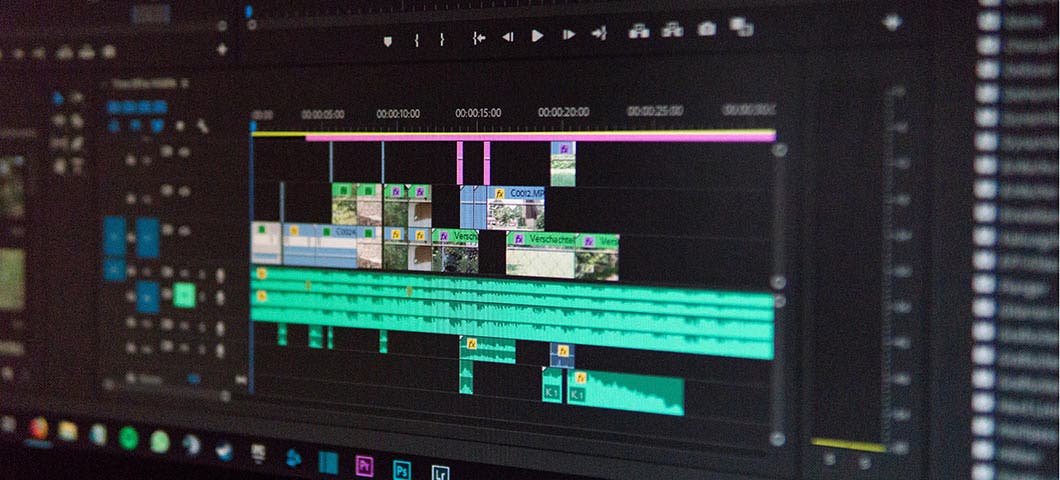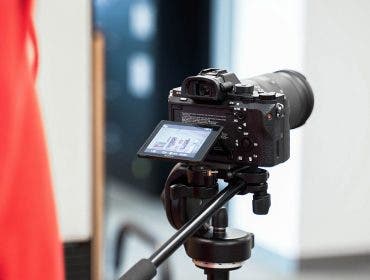When first embarking on a videography career, it’s easy to make do with a simple laptop and hard drive setup. It’s portable. It’s (relatively) inexpensive. And it’s one less piece of gear you have to worry about. After a few years, though, your needs change. A small screen with mediocre resolution will only get you so far. You need 4K quality, true-to-life colors, and a larger workspace (potentially a dual monitor setup) to perfect your video projects. That’s why, at a certain point, you may need one of these monitors for video editing.
A desktop monitor — particularly one with 4K capabilities — will help you achieve accurate color grading, precise transitions, and editing efficiency, all with top-notch resolution. But it’s not as easy as scooping up the first 4K video editing monitor you see. Here are three things to know before buying:
- Pay attention to design: While you may be drawn to monitor image features such as the color system, don’t forget to look at the functionality. Make sure your monitors for video editing will fit into your workspace seamlessly, and, if you travel frequently, take a look at the monitor’s portability. Some often have handles.
- Take note of refresh rate: While a 30Hz refresh rate works for day-to-day monitors, video editors will need closer to a 60Hz refresh rate for speed and accuracy. (Refresh rate is how many times the screen refreshes in one minute.)
- There are two types of 4K resolution: If your camera records 4K video in DCI 4K (4096×2160) then you’ll want a DCI 4K monitor. If your camera records in UHD 4K — the more common resolution, which is 3840×2160 — then you’ll want a UHD 4K monitor for video editing.
With these specifics in mind, it’s time to get to buying. Here are five of the best 4K video editing monitors on the market right now:
BenQ SW271C 27″ 16:9 4K UHD IPS Monitor
BenQ is one of the top names in monitors for video editing thanks to their always-impressive specs.
The SW271C PhotoVue is a fantastic option for videographers looking for a precise color accurate monitor. With a 10-bit color depth, BenQ’s own Uniformity Technology for consistent corner-to-corner color, and high dynamic range formats, videographers can spend more time editing and less time calibrating.
BenQ monitors come with helpful accessories like a shading hood for reducing glare from ambient lighting, USB-C ports, and the Hotkey Puck G2 for accessing shortcut presets and streamlining your workflow.
For a more affordable version of this top of the line display that doesn’t skimp on monitor specs, check out the BenQ 27” SW270C display.
Key Specifications
- 27” LED Anti-Glare Backlight Display
- 1.07 billion colors
- 60Hz Refresh Rate
- HDR with 24/25/30P video format support
- 2x HDMI v2.0 ports, 1x DisplayPort v1.4, 1x USB-C Port
- SD Card Reader
LG 34WP88C-B 34″ 21:9 UltraWide QHD IPS Curved Monitor
The LG 34WP88C-B’s ultra-wide curved display was crafted with photographers, video producers, and creative professionals in mind. This ultra-wide monitor offers massive real estate for tackling big projects, with a resolution of 3440×1440, a refresh rate of 60Hz, and split-screen capabilities.
This display is also packed with helpful monitor image settings. Reader Mode reduces blue light for more comfortable reading without eye strain, while Flicker Safe dimming technology keeps your eyes comfortable when you’re logging long hours at your workstation.
The flexible ergonomic stand is a great add-on. The stand keeps cords tucked away for a clutter-free desktop so you can focus on your work and not on straightening up. With all these features, it’s one of the most thoughtfully designed monitors for video editing on the market.
Key Specifications
- 34” Curved IPS Display
- 3440 x 1440 Resolution
- 1.07 billion colors
- 60Hz Refresh Rate
- HDR10
- IPS with DCI-P3 95% (Typ.)
- 2x HDMI v2.0 ports, 1x DisplayPort v1.4, 1x USB-C Port
Asus ProArt PA329C 32″ 16:9 4K Ultra HD IPS LCD Monitor
4K monitors are rapidly becoming the industry standard, and this impressive display from Asus is a great entry model for videographers. Certified HDR-10 visuals create a lifelike experience, with 138 pixels per inch. That’s four times the pixel density of other monitors for video editing in its class.
This monitor comes pre-calibrated right out of the box, too, so you can jump right into your creative projects. Color profiles are saved on an internal scaler IC chip instead of your computer, so you can connect the monitor to different devices without needing to recalibrate.
Unique Picture by Picture mode makes it easy to align two separate input sources on the same screen. You can also use Picture in Picture mode to reduce one input to a thumbnail and enlarge the other. It’s like having a second monitor on demand.
Key Specifications
- 32” 4K Ultra HD IPS LCD Display
- 3840×2160 Resolution
- 1.07 billion colors
- 60Hz Refresh Rate
- HDR10
- 98% DCI-P3, 100% Adobe RGB, 100% sRGB and 84% Rec.2020
- HDMI ports, DisplayPort, USB-C port
Apple Pro Display XDR 32″ 16:9 Retina 6K HDR IPS LCD Display
When a 4K monitor won’t cut it, Apple’s Pro Display XDR 32” monitor is a terrific solution. This 6K HDR IPS LCD display is the most configurable and expandable Apple monitor ever. With up to 1600 nits of brightness, a 1,000,000:1 contrast ratio, and a superwide viewing angle, there’s virtually nothing this display can’t handle.
Using industry-leading polarizer technology, the Pro Display XDR demonstrates exceptional color and contrast regardless of your viewing angle. So whether you’re video editing solo or presenting to a large team, every viewer will see the same quality footage and color rendering.
If you’re a Mac enthusiast looking for the best monitor for video editing, this is the display for you.
Key Specifications
- 32” 16:9 Retina 6K HDR IPS LCD Display
- 6016 x 3384 Resolution
- 1.07 billion colors
- 60Hz Refresh Rate
- 2D backlighting system using 576 full array local dimming zones
- 1x USB Type-C (Thunderbolt 3), 3x USB Type-C 2.0
Dell UltraSharp UP2720Q 27″ 16:9 4K PremierColor IPS LED Monitor
Monitors for video editing need reliable visuals regardless of viewing angle. Dell’s UltraSharp UP2720Q features Uniformity Compensation for consistent brightness corner to corner. Meanwhile, the detachable shade hood combats ambient glare and reflection.
A convenient built-in colorimeter makes it easy to calibrate your monitor as needed or on a preprogrammed schedule. No matter how often you use your display, this color accurate monitor will always deliver consistent image fidelity. With a pixel density of 163ppi, this model offers more than enough resolution for most projects.
This Dell UltraSharp also takes comfort and convenience seriously. Abundant ports and slots provide access for all your devices, while ergonomic positioning makes long days at the screen fly by.
Key Specifications
- 27” LED-backlit LCD monitor / TFT active matrix
- 4K 3840 x 2160 Resolution
- 1.07 billion colors
- 60Hz Refresh Rate
- Built-in Calibration Sensor
- 1x DP 1.4, 2x HDMI 2.0, 2x Thunderbolt, 2x USB 3.2 Gen 2, 2x USB 3.2 Gen1 ports
Finding the Best Video Editing Monitor for Your Needs
Selecting the perfect monitors for video editing can take some effort. With so many impressive displays on the market, the shopping experience can quickly become overwhelming. Rather than relying solely on comparing monitor specs, a few other key considerations can help you find the perfect monitor more easily.
Screen Size
First and foremost, consider screen size. Bigger is often better if you have the space for it at your workstation. These days, a 27” monitor is considered the minimum size for an effective workflow. A curved monitor is often the best monitor for video editing because it provides a more immersive experience.
Plenty of Ports
Most external and second monitors are designed for HDR support and a 60Hz refresh rate, so make sure to prioritize other features like port access, ergonomics, and on-board calibration.
Scheduled Calibration
Ultimately, the monitor that requires the least amount of upkeep will save you time and effort in your workflow. That’s why the ability to schedule calibrations and store multiple color profiles is so beneficial.
Taking Your Video Editing Tools a Step Further
Once you’ve found the perfect monitors for video editing, it’s helpful to invest in a few other useful accessories.
Ergonomics
For starters, comfort is key. Your workstation should be designed with ergonomics and fatigue resistance in mind. Thankfully, most of the monitors listed above make comfort a major design focus. Take ergonomics one step further by investing in a top-of-the-line gaming chair to avoid neck and back strain so you can focus on your work.
Monitor Accessories
Video editing keyboards and stylus tablets will also improve and streamline your workflow so you can seamlessly navigate any video editing software you can imagine.
To amplify your video editing setup further, it may be time to invest in a desktop computer. These powerhouses are significantly speedier than laptops when it comes to processing, with at least 1TB of storage space. Here are eight of our favorite photo and video editing desktop computers.






